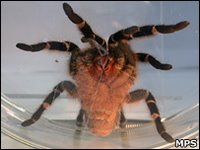
And you thought Spiderman was impressive...
German scientists have revealed that tarantulas climb vertical walls by oozing a super-adhesive silky substance - through their feet.
The spider's extraordinary ability to defy gravity has long been attributed to a combination of their claws and the tiny hairs that are attached to their feet. The latter form weak electro-magnetic attractions that attach the spider to solid surfaces. Their silk-spinning skills have been well-documented too. The sticky silk is pumped out through abdominal structures known as spinnerets and is used, amongst other things to capture prey and form protective shields for the spiders' young.
But it is only now that scientists have spotted spiders generate the glue-like substance through their feet as well, providing them with a third method for fixing themselves to sheer surfaces.
"We have discovered that the tarantula has a third attachment mechanism, which depends on fibres exuded from nozzle-like structures on its feet," said Stanislav Gorb, from the Max Planck Institute for Developmental Biology in Tubingen, Germany, who reported the discovery in this week's Nature. "These fibrous secretions function as silken tethers and, when laid down on glass plates, appear as 'footprints'."
The results have caused a real stir in scientific circles. Spider expert Professor Fritz Vollrath from Oxford University told the BBC today that the idea of arachnid's spinning foot silk had been regarded as something of an "old wife's tale". "It's incredible - just like Spiderman. If the stuff is so good he can pull a train around, how does he get it off? And that's the thing for the spiders: first they have to glue themselves down and then they have to get themselves off again. It's very clever," he said.
The discovery is exciting from an evolutionary perspective too. It raises the question of which came first, foot silk or abdominal silk. Or did spiders evolve the two techniques separately?
Photo: Max Planck Institute
No comments:
Post a Comment